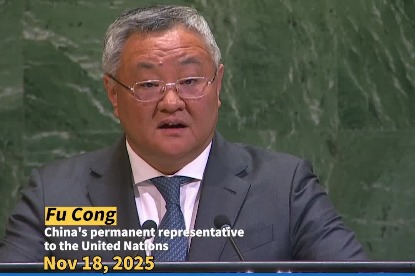Experts voice concerns over tariffs' far-reaching impact

The re-emergence of tariffs under US President Donald Trump's administration is raising many concerns about their negative impact on the United States, other nations and the global trading system.
That was among the sentiments expressed by experts at a May 21 event at the Peterson Institute for International Economics (PIIE) titled "Tariffs, Tariffs, Tariffs". The forum offered a deep dive into the evolving landscape of global trade policy.
Cecilia Malmström, a non-resident senior fellow at the PIIE and the event's moderator, set the stage by saying that the word "tariff" is "certainly one of the most used today".
A May 12 agreement by the US and China in Geneva reduced US tariffs on China to 30 percent and Chinese tariffs to 10 percent for 90 days, though Trump recently claimed China "violated" this deal, raising fears of renewed escalation. The Chinese Foreign Ministry on Tuesday criticized the characterization of the deal and offered examples of US violations of the deal.
This week, US-China talks are focusing on rare earth minerals, signaling new negotiation priorities. On May 28 and 29, a federal court ruled against the use of the International Emergency Economic Powers Act for tariffs, though the levies remain in effect pending appeals.
Chad Bown, a senior fellow at the PIIE, said it was a challenge to glean the administration's ultimate goals. He said that the president and the administration "have laid out a number of objectives for what they want these tariffs to achieve, and some of them are just incompatible with each other".
The 10 percent rate on most countries is viewed as non-negotiable revenue sources, Bown said. "They want those for tax revenue purposes."
Others, under Section 232, are imposed on national security grounds for items like steel, aluminum, autos and parts.
"We're probably likely to see higher tariffs in some of those sectors later on," he said, indicating that additional tariffs in critical sectors like semiconductors and pharmaceuticals are likely.
Bown mentioned that while previous administrations also worried about supply chain vulnerabilities, they recognized that "tariffs don't really seem to be the solution on their own to solving these problems".
He also said that tariffs on goods from Canada and Mexico not complying with rules of origin under the United States-Mexico-Canada Agreement also might serve as leverage for upcoming renegotiations.
Bown pointed to the persistently high tariffs on Chinese imports, which averaged 21 percent before the Trump administration and have now surged to 51 percent with new additions, such as those targeting fentanyl.
The "end game" for the US-China trade relationship, he said, remains unclear. Canada is currently boosting interprovincial trade to reduce reliance on US markets, adapting to tariff pressures.
Arancha González Laya, dean at the Paris School of International Affairs at Sciences Po and former foreign minister of Spain, offered the European perspective, describing the situation as "very difficult to understand because what you see is multiple contradictory objectives with the wrong tool".
She said it is an "undoing of the 'quote, unquote' international trade order", while the current trade uncertainty has risen "well above the highest we've seen in the last decades, which was essentially COVID".
González Laya said that Europe's main concerns include if the US' tariff action is "a unilateral re-drafting or rather basically wrecking the international trade order"; the tariff announcement is "renouncing to open markets"; and "very nasty targeting of the world's poorest countries".
"The one the European Union (EU) has chosen is basically to be strategically patient and to let others do the running," she said, noting that the EU is hoping market forces, particularly bond markets, will compel the US to "course correct".
The EU is now preparing retaliatory tariffs on $95 billion of US goods, escalating trade tensions. Currently facing 20 percent tariffs, the EU was also targeted with a proposed 50 percent tariff, deferred to July 9, adding further uncertainty to EU-US trade relations.
Panelists also discussed the US administration's focus on trade deficits in goods, with Malmström questioning why successful US services exports are often excluded from such calculations.
Bown said that "politicians I have observed tend to pick the facts that suit them and the arguments that they want to make and not necessarily all of the facts". He said that the trade deficit is fundamentally linked to macroeconomic factors, making tariffs an inconsistent tool to address it.
On the impact of US tariffs on China, Malmström said that China is actively working to diversify its markets, particularly by strengthening engagement with its Asia-Pacific neighbors and launching a "charm offensive visa with the European Union to try to see can we trade more with each other".
González Laya challenged the notion that the US can simply stop importing from China. "When we hear that the US is going to import less from China, OK, import less of what? Not of consumer electronics, which it imports a lot of because they are basically made in China. Not of toys, because there is nowhere in the world that can produce cheaper toys than from China," she said.
The prospect of reopening negotiations on the EU-China Comprehensive Agreement on Investment (CAI), which Malmström said is currently in a "freezer", was also raised by González Laya.
She said that Chinese investments in Europe are increasing and that "there are voices in the European Union who are now calling for it to maybe be reopened and to sit and talk to China".
González Laya also pointed out that if the US is the sole country raising protection levels, it will ultimately harm itself. She stressed the critical role of the "87 percent" of global trade (excluding the US) in maintaining existing rules and market access, saying that the EU, China and Japan are "very important to orchestrate" efforts to keep the global economy open.
Regarding the future of the global trading system, González Laya listed three potential paths for the World Trade Organization (WTO): accepting less stringent rules to keep the US engaged, allowing other members to update rules and open markets without the US, or maintaining the WTO's review and dispute settlement functions while members pursue new rules or market access outside its direct framework.
A recent WTO report projects a 0.2 percent decline in 2025 global trade due to tariffs, downgrading earlier growth forecasts. She anticipated that "variable geometry will be the name of the game", with more sectoral and limited deals.
Bown said that the trading system has not adequately adapted to new "economic security concerns" arising from highly efficient global supply chains.
Bown said that with the recent de-escalation with China potentially leading to increased imports for Christmas, the overall impact on prices and inflation remains to be seen to predict amid conflicting developments.
"It's impossible (to predict). So, we'll wait and see," Bown concluded.
yifanxu@chinadailyusa.com
































